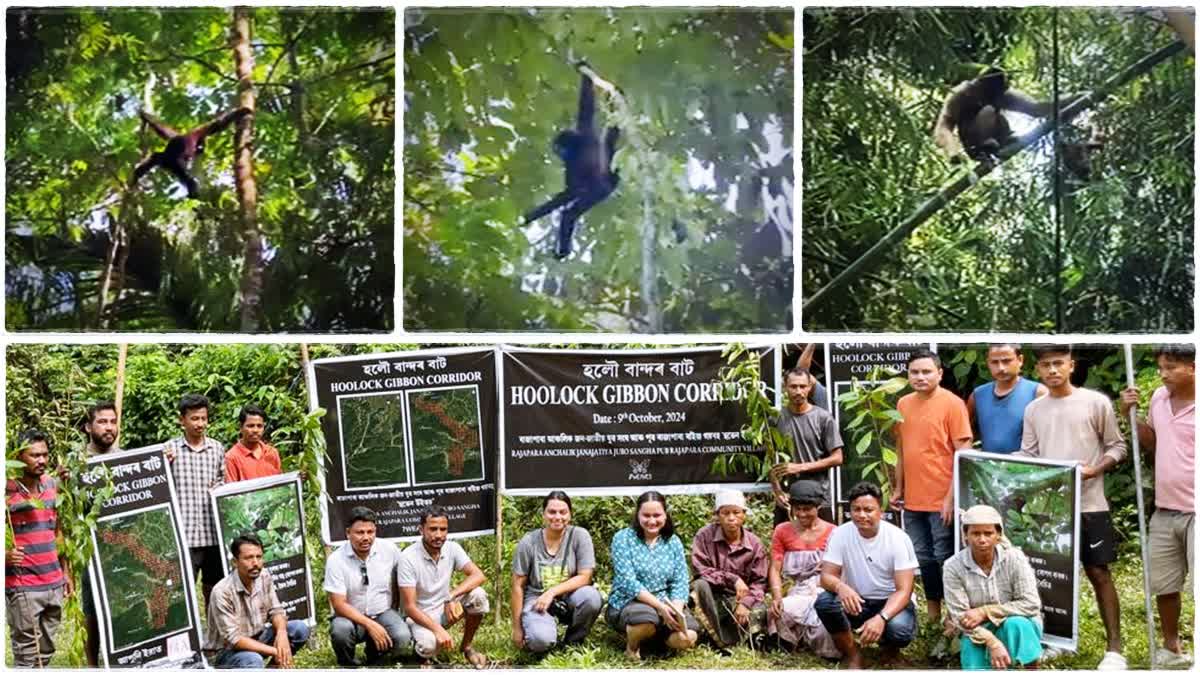Guwahati: In a unique move to ensure existence of the endangered Hoolock Gibbons, the villagers of Chandubi on Monday demarcated a corridor between two reserve forests that are normally used by Hoolock Gibbons.
The demarcation will ensure free movement of the Hoolock Gibbons between Mayong reserve forest and Bordowa reserve forest which houses about seven families of Hoolock Gibbons, listed as endangered and vulnerable species by the International Union for Conservation of nature (IUCN).
Pub-Rajapara Forest village and Pub Rajapara Aanchalik Janajatiya Jubo Sangha , a local community organization based in Rajapara and Chandubi area in Assam's Kamrup district took the initiative in association with a 7WEAVES, an organization working for community welfare and conservation of wildlife.
"The Chandubi area along with Rajapara, Gutipathar, Ginpota, Joramukharia are full of biodiversity. There are seven families of Hoolock Gibbons here that keep on moving between their habitats in Mayong and Borduar reserve forests. However, with the focus on development works such as widening of roads, agriculture activities etc have been affecting the biodiversity in multiple ways," said Pokhiraj Rabha, President of the Rajapara Anchalik Tribal Youth Sangha.
Rabha said that it is very important to demarcate the wildlife corridors to ensure that the development works do not affect the wildlife and the rich biodiversity of any particular area. "Keeping this goal in mind we have launched this initiative to protect the biodiversity of Chandubi and its adjoining areas," said Rabha.
"This is one of the last remaining primary forests in Kamrup and home to the endangered Hoolock Gibbons, which the local villagers have conserved for generations," he said.
Worth mentioning here that the Hoolock Gibbons live together in monogamous pairs and do not mate within the family. They also stake out a territory and their calls serve to locate family members and ward off other gibbons from their territory. The monogamous habit of the Hoolock Gibbons makes it necessary to ensure that there is substantial movement between colonies to ensure their survival.
It may be mentioned here that the local forest communities along with 7WEAVES Research for the past three years have identified the Hoolock Gibbon families and their habitat in the Barduar and Mayong Reserved Forests, locating three in Barduar and four families in Mayong. The landscape studies carried out by the two organizations have revealed alarming indications of forest fragmentation in these areas, particularly threatening wildlife corridors that connect vital habitats.
"Recognising the threats to the Hoolock Gibbons and the wider ecosystem, the residents of Pub-Rajapara have mobilised to conserve these precious habitats, identifying a crucial corridor that has been the traditional route between Mayong and Barduar Reserved Forests," said Tanya Talwar, one of the researcher of 7WEAVES.
"To mark the beginning of the Hoolock Gibbons Corridor (called Holou Bandor baat in Assamese) initiative, the community has arranged an official walk along the identified traditional corridor to demarcate it for long-term conservation. As a symbol of their commitment to restoration, the community today planted 100 saplings as a start and to enhance the forest canopy," she said.
The demarcation and adoption of the current patch will prevent the change in future encroachment or in land use, Rabha said. "There are some plots within the corridor which are under cultivation, and this initiative will help conserve those areas by planting and protecting the existing trees," he said.



